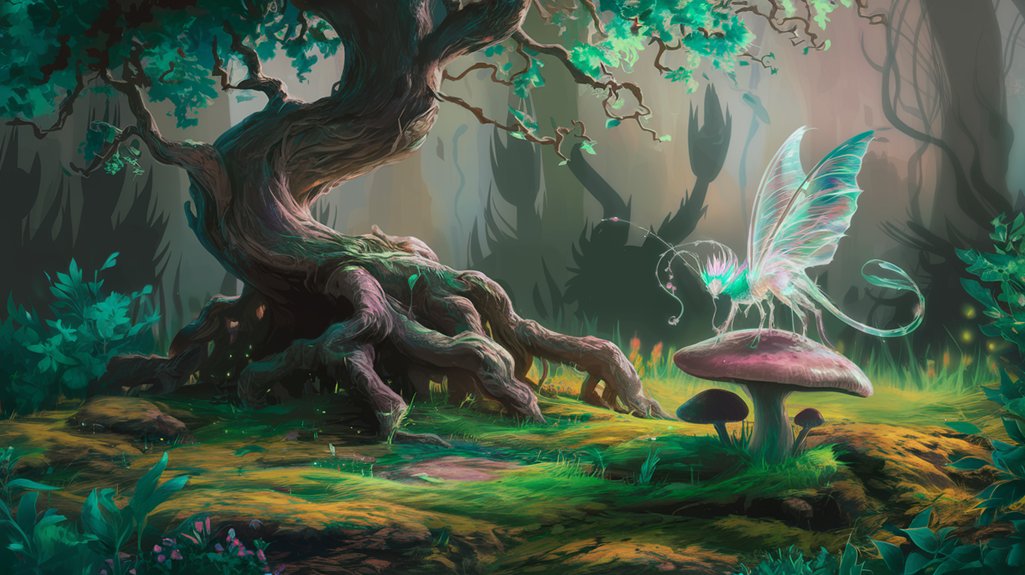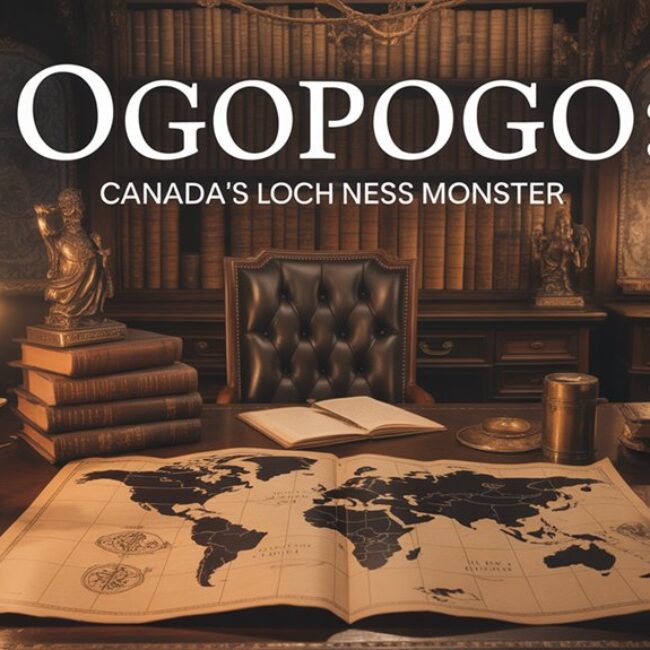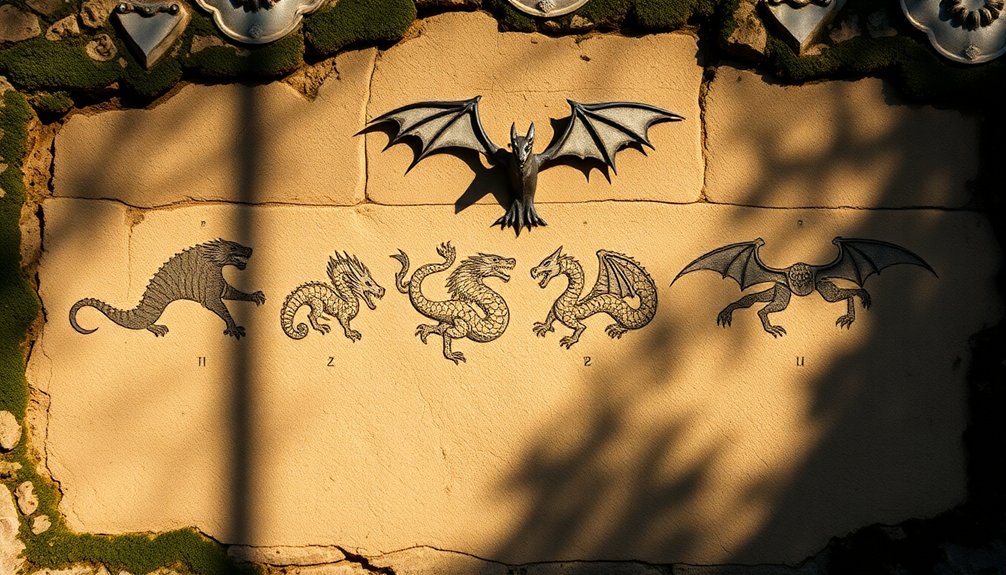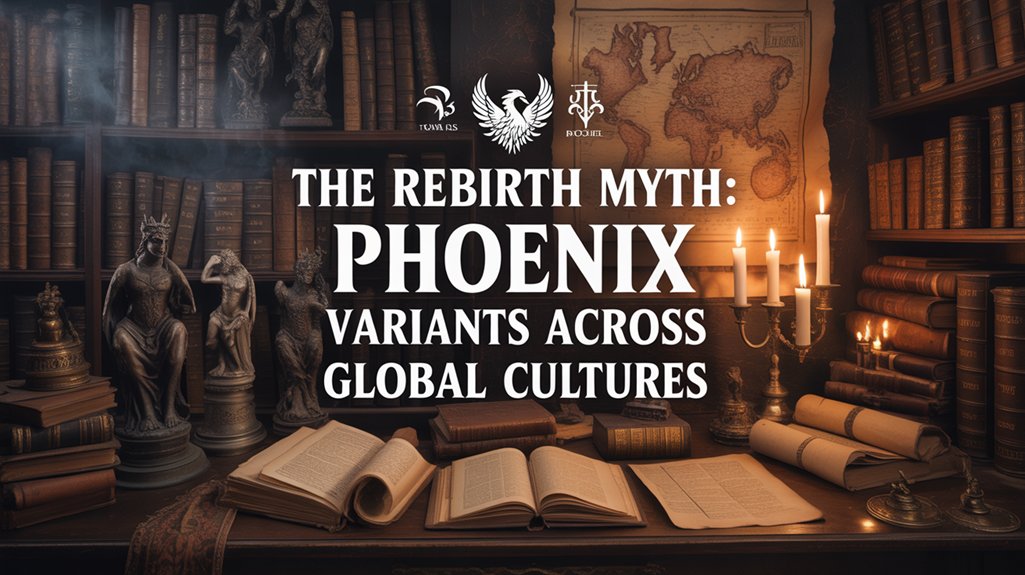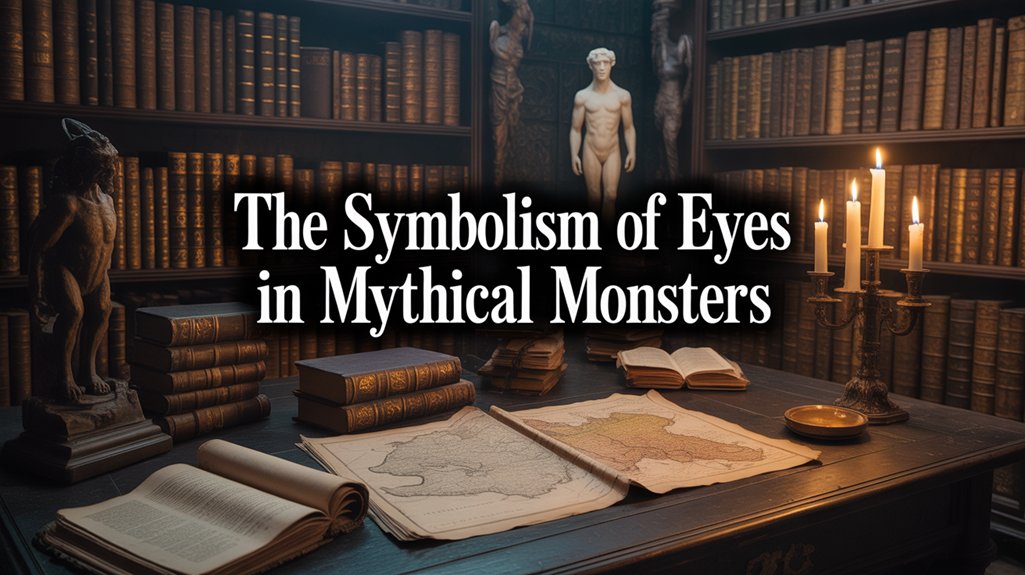
You’ll discover seven creatures that haunted maritime consciousness: the Kraken’s tentacled enormity, validated by forty-three-foot *Architeuthis dux* specimens; Leviathan’s biblical chaos embodied in sperm whales; serpentine entities cataloged in nineteenth-century ship logs; mermaids born from manatee silhouettes; Japan’s Umibōzu rising from Pacific depths; the Bahamas’ tentacled Lusca; and Tiamat’s Mesopotamian coils preserved in 1750 BCE cuneiform tablets. These chimeric testimonies, once dismissed as sailor exhaustion, now bridge superstition and taxonomy as oceanography uncovers abyssal truths that ancient scribes etched into clay millennia before modern science ventured into those unexplored trenches.
Table of Contents
ToggleKey Takeaways
- Kraken: Norse sailors described giant tentacled creatures dragging ships underwater, later validated by giant squid specimens reaching forty-three feet.
- Leviathan: Biblical accounts of colossal sea beasts swallowing mariners whole paralleled actual sperm whale encounters in ancient maritime cultures.
- Sea Serpents: Ship logs worldwide documented serpentine creatures with draconic heads, likely misidentified whales breaching through fog.
- Mermaids: Exhausted sailors mistook manatees and dugongs for ominous half-human creatures, creating widespread maritime folklore.
- Regional Monsters: Cultural legends like Japan’s Umibōzu and the Bahamas’ Lusca served as cautionary tales for seafarers.
Terror From the Deep Oceans

When mariners ventured beyond the sight of land, they entered a domain where waves concealed horrors that defied terrestrial logic. The Kraken emerged from Norse traditions as an eldritch manifestation of the abyss itself, its tentacled form dragging vessels into crushing darkness—likely rooted in encounters with Architeuthis dux, the giant squid.
Beyond sight of shore, sailors confronted the Kraken—an eldritch horror born from the abyss, dragging ships into crushing, tentacled oblivion.
Sea serpent sightings proliferated throughout the 1700s and 1800s, their chimeric bodies coiling through ship logs with dragon-headed certainty. These weren’t mere fantasies. They were desperate attempts to codify the unknowable.
The Leviathan surpassed folklore, representing primordial chaos in biblical scripture, an entity that swallowed men whole.
Mermaid myths, darker than contemporary sanitization suggests, stemmed from manatee encounters—hope altered into haunting femininity during endless oceanic isolation.
The Caribbean’s Lusca blended octopoid nightmare with shark ferocity, claiming sailors through blue holes, those vertical abysses where light surrenders.
You’re witnessing humanity’s struggle to comprehend what swims beneath consciousness itself. Some of these aquatic terrors eventually joined the ranks of former cryptids, their existence validated through scientific methodologies that transformed sailor testimony into zoological fact.
##
You stand at the threshold where empirical observation intersects with primordial dread, examining centuries of maritime testimony that altered the ocean’s unknown depths into a repository of eldritch horrors.
These accounts—recorded in ship logs, carved into coastal monuments, whispered through generations of fishing communities—demand rigorous analysis across four essential dimensions: the ancient narratives that first codified these terrors, the tangible traces left behind as evidence, the cultural frameworks that birthed such chimeric imaginings, and the contemporary scientific lens that attempts rational explanation.
Each dimension reveals how humanity has eternally grappled with the abyss that lies beneath our vessels, that liminal domain where known biology dissolves into nightmare.
Ancient Mariner Terror Tales
As vessels carved through uncharted waters during humanity’s earliest maritime ventures, sailors accumulated a lexicon of terror—accounts of eldritch entities lurking beneath the waves, waiting to manifest when the moon hung low and the sea turned unnaturally still.
You’ll find Kraken folklore dominated these narratives, describing tentacled behemoths capable of dragging entire ships into abyssal depths—tales likely rooted in deep-sea squid encounters.
Leviathan symbolism pervaded ancient texts, representing primordial chaos: a colossal creature that crushed vessels, swallowed mariners whole. These weren’t mere superstitions; they embodied humanity’s primal confrontation with oceanic vastness.
Sea serpents coiled through logbooks, their horse-like or draconic heads breaking surfaces worldwide.
Even mermaids emerged as ominous harbingers rather than benevolent spirits, appearing when exhaustion blurred reality’s edges, altering distant manatees into chimeric warnings.
Like the Wendigo of indigenous lore, these maritime monsters served as cautionary tales that reflected the profound dangers sailors faced and the psychological toll of isolation at sea.
Physical Evidence and Sightings
Though maritime mythology endured for millennia as oral tradition, the nineteenth century witnessed unprecedented documentation—ship captains committed encounters to official logs, naturalists preserved biological specimens, photographers captured anomalous forms.
You’ll find monster sightings meticulously recorded throughout this era, each testimony bearing the weight of professional reputation. Evidence analysis converted speculation into scientific inquiry when Giant Squid carcasses finally validated centuries of sailor testimony. These eldritch specimens, measuring forty feet in length, vindicated those dismissed as superstitious.
The 1997 Bloop recording demonstrated how technology reveals oceanic mysteries—initially deemed evidence of chimeric leviathans, later attributed to ice quakes. Yet uncertainty persists. Blue holes swallow vessels still.
Ship logs from the 1700s catalog serpentine entities with horse-like heads. Physical proof emerged gradually, tantalizingly. The deep refuses complete revelation.
Cultural Origins and Myths
Before mariners charted coordinates or philosophers codified natural law, civilizations carved their terror into constellation and scripture—the ocean’s abyss birthed monsters that prowled the boundaries of human comprehension.
You’ll find the Kraken’s tentacles writhing through Norse sagas, the Leviathan coiling through biblical apocalypse. These weren’t mere fabrications. The Jörmungandr, that world-encircling serpent, embodied Ragnarok itself—mythical origins intertwined with observed phenomena, eldritch shapes breaching storm-dark waters.
Mermaids, chimeric and foreboding in early accounts, emerged from desperate sailors mistaking manatees for companions. Cultural significance deepened through regional legends: Japan’s Umibōzu, the Bahamas’ Lusca.
Each tradition wrestled with disappearances, altering environmental mysteries into sacred narrative. These weren’t superstitions to dismiss—they were humanity’s first cartography of the unknown.
Modern Scientific Explanations
While ancient cartographers inscribed *hic sunt dracones* at the edges of understanding, modern oceanography has dragged leviathans into laboratory light—yet the dissolution of myth into taxonomy doesn’t diminish the ocean’s capacity for horror, merely refocuses it.
Scientific discoveries have transmuted the Kraken’s eldritch tentacles into *Architeuthis dux*, forty-three feet of cephalopod muscle. Marine biology explains your ancestors’ mermaids as dugongs—chimeric mammals whose fleeting silhouettes birthed entire mythologies.
The Leviathan’s biblical enormity finds corporeal form in sperm whales, creatures whose very existence defies comprehension. Even the Bloop’s abyssal resonance, attributed to ice quakes, reminds you that unknown territories persist.
Sea serpents? Misidentified whales breaching through fog. Each revelation strips away one layer of mystery, only to expose another beneath.
Babylonian Tablets and Greek Scrolls
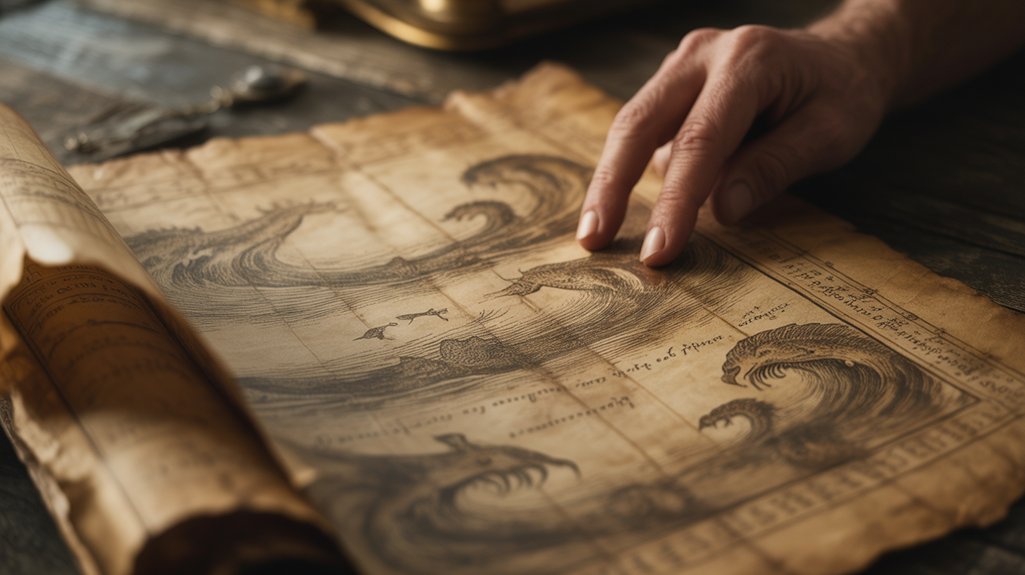
You’ll find the earliest recorded testimonies of eldritch sea beasts etched into cuneiform tablets from Mesopotamia’s temple archives, circa 1750 BCE, where priests catalogued chimeric horrors rising from the primordial abyss—creatures that would later resurface in Hellenistic manuscripts as sailors exchanged tales along Mediterranean trade routes linking Phoenician ports to Mycenaean harbors.
These maritime corridors became vessels for myth itself, carrying accounts of Sumerian flood monsters northward into Greek waters, then beyond to Nordic fjords where similar serpentine leviathans coiled through saga and skaldic verse.
The shared vocabulary of maritime terror, transmitted through merchant ships and coastal sanctuaries, reveals an ancient recognition: that certain waters breed certain nightmares.
Sumerian Flood Myth Creatures
Among the cuneiform-inscribed tablets unearthed from ancient Mesopotamian ruins, the Sumerian flood narratives stand as humanity’s earliest written record to cataclysmic deluge—and to the eldritch beings that swam through those primordial waters.
You’ll find Utnapishtim’s survival interwoven with chimeric entities like Tiamat, the serpentine goddess whose scales reflected chaos itself, her form undulating through apocalyptic tides. This Sumerian symbolism merged divine retribution with tangible terror, where flood waters didn’t simply drown—they carried monsters.
The Babylonians inherited these maritime nightmares, expanding upon primordial oceanic deities that embodied humanity’s deepest fears. These weren’t mere allegories; sailors genuinely believed such creatures lurked beneath storm-tossed waves, waiting to drag vessels into abyssal depths.
Ancient scribes preserved these warnings, etching humanity’s relationship with the unknowable sea into clay that would outlast empires.
Mediterranean and Norse Waters
As civilizations flourished across the Mediterranean basin and into the storm-wracked fjords of Scandinavia, their maritime chronicles carved a bestiary of oceanic horrors into clay, papyrus, and runic stone. You’ll find Babylonian tablets depicting Leviathan—that primordial serpent embodying chaos itself. Mediterranean myths conjured Charybdis, whose whirlpool maw devoured entire fleets, while Sirens converted temptation into shipwreck through eldritch song.
| Entity | Origin |
|---|---|
| Leviathan | Babylonian |
| Charybdis | Greek |
| Sirens | Mediterranean |
| Kraken | Norse |
| Jörmungandr | Norse |
Norse legends brought forth Jörmungandr, the world-serpent whose chimeric form encircled Midgard, and the Kraken—that tentacled doom lurking beneath Norwegian waters. These weren’t mere superstitions. They represented humanity’s confrontation with oceanic vastness, freedom’s price written in salt and terror.
Ancient Maritime Trade Routes
When Babylonian merchants etched cuneiform accounts of their voyages circa 2000 BCE, they weren’t merely recording cargo manifests—they were mapping humanity’s first systematic confrontation with the abyss.
These tablets chronicle maritime commerce across the Persian Gulf and Mediterranean, where ancient navigation demanded courage beyond calculation.
By the 4th century BCE, Greek scrolls catalogued eldritch encounters along trade routes—chimeric serpents, tentacled leviathans, creatures that embodied the ocean’s unknowable depths.
Herodotus preserved these testimonies in the 5th century BCE, refusing to dismiss sailors’ certainties.
The “Periplus of the Erythraean Sea” later mapped Red Sea passages where commerce and cosmic dread intertwined.
You’re witnessing freedom’s price: these mariners ventured beyond charted waters, their monster tales serving as navigation warnings, spiritual boundaries, cultural currency exchanged alongside spices and silk.
Caribbean Vs Nordic Legends

Deep within the cerulean expanses of Caribbean blue holes lurks the Lusca—a chimeric terror that melds the crushing tentacles of a colossal octopus with the serrated fury of shark anatomy. You’ll find these Lusca characteristics embedded in local fishermen’s warnings, cautionary tales whispered across generations. Meanwhile, northern waters harbored their own eldritch nightmare.
| Attribute | Caribbean Lusca | Nordic Kraken |
|---|---|---|
| Habitat | Blue hole caverns | Deep ocean trenches |
| Physical Form | Octopus-shark hybrid | Tentacled leviathan |
| Cultural Function | Local maritime caution | Explanation for disappearances |
Kraken comparisons reveal striking parallels: both embodied sailors’ primordial dread of unfathomable depths. The biblical Leviathan echoes this pattern—immense, destructive, incomprehensible. These weren’t mere superstitions but frameworks through which you’d interpret genuine maritime dangers. Caribbean folklore protected local communities; Nordic sagas rationalized losses in treacherous waters. Different seas, identical fear.
Religious Warnings Against Hubris
Beyond entertainment or ecological explanation, these aquatic leviathans served as theological instruments—divine cautionary tales carved into the collective consciousness of maritime cultures.
You’ll find hubris consequences woven throughout maritime folklore, where eldritch creatures emerged as manifestations of divine order itself. The Leviathan—that chimeric behemoth of biblical proportions—warned against challenging nature’s sovereignty.
Sea monsters weren’t mere beasts—they were divine instruments, punishing mortal arrogance with primordial fury.
Consider how sailors interpreted these encounters:
- The Leviathan’s immense power demonstrated humanity’s insignificance before creation’s primordial forces.
- Sea Dragons materialized when mortals defied natural boundaries, their serpentine forms embodying retribution.
- Sirens beckoned prideful navigators toward rocky doom, punishing those who believed themselves masters of the waves.
- Divine retribution manifested through monstrous apparitions, reminding seafarers that humility preserved life.
These weren’t mere superstitions—they represented theological frameworks governing human behavior.
Ancient mariners understood: the ocean recognized arrogance. Challenge its depths without reverence, and something ancient, something hungry, would rise to correct your presumption. The sea remembers. Always.
Moby Dick and The Odyssey
You’ll find that Melville’s “Moby Dick” and Homer’s “The Odyssey” stand as twin pillars of maritime literature, each channeling the eldritch terror of the deep into narratives where obsession meets the monstrous.
Captain Ahab’s vengeful pursuit of the great white leviathan echoes Odysseus’s perilous encounters with Charybdis, the Sirens, and the Cyclops Polyphemus—chimeric beings born from sailors’ genuine fears of the ocean’s unfathomable darkness.
These works weren’t conjured from pure imagination; they emerged from centuries of maritime folklore, where reality’s dangers—tempests, colossal squids, aggressive whales—transformed through oral tradition into the mythological beasts that’ve haunted seafarers’ dreams since humanity first sailed beyond sight of land.
Melville’s White Whale Legend
When Herman Melville penned *Moby Dick* in 1851, he didn’t merely chronicle the American whaling industry’s brutal realities—he resurrected the primordial terror that Homer had inscribed into Western consciousness nearly three millennia earlier.
You’ll recognize Captain Ahab’s monomaniacal pursuit as humanity’s eternal struggle against nature’s eldritch supremacy, that same force which altered Scylla and Charybdis into navigational nightmares for Odysseus.
The white whale transcends cetacean biology, becoming chimeric—part Leviathan, part Kraken, wholly supernatural.
Melville understood what ancient mariners knew: certain creatures inhabit liminal spaces between myth and matter, their presence challenging rationalist certainty.
When Ahab rages against the pale behemoth, you’re witnessing mankind’s futile attempt to conquer mysteries the ocean refuses to surrender, that primordial darkness sailors have respected, feared, and sworn existed since antiquity’s first voyage.
Odysseus Encounters Sea Monsters
The Strait of Messina narrows to its infamous choke point where Odysseus confronted maritime horror in its purest dyadic form—Scylla’s six ravening heads protruding from her cavern lair on one precipice, Charybdis’s abyssal maw churning the waters below the opposite cliff.
You’ll recognize in this mythical navigation the eldritch calculus of survival: sacrifice six crew members to Scylla’s terror or risk total annihilation in Charybdis’ danger.
Odysseus’ bravery manifested not through reckless defiance but through grim acceptance of unavoidable loss. This chimeric gauntlet represented something beyond mere monsters—it embodied the ocean’s fundamental indifference to human aspiration.
Ancient Greek sailors understood these weren’t cautionary tales but navigational realities, where supernatural threats demanded supernatural wisdom. Freedom upon the wine-dark sea required acknowledging forces beyond mortal comprehension.
Fiction Inspired by Reality
Where ancient Greek hexameters first carved the contours of oceanic terror into Western consciousness, Herman Melville’s nineteenth-century American epic refined that primal dread through the lens of industrial whaling’s brutal machinery.
You’ll find Ahab’s monomaniacal pursuit mirrors Odysseus’s navigation past Scylla and Charybdis—both captains wrestling with forces beyond mortal comprehension.
The sailor folklore that birthed Homer’s chimeric horrors drew from actual encounters with leviathans beneath Mediterranean swells. Melville altered this mythological creatures tradition, channeling real whaling experiences into fiction.
Both authors understood the ocean’s eldritch psychology: how isolation breeds visions, how the abyss stares back. Their narratives occupy that liminal space where documented maritime peril transmutes into myth, where sailors’ testimonies of monstrous beings become eternal literature, binding reality’s anchor to imagination’s sail.
Jaws and Godzilla Films
These films codified modern maritime terror through:
- Altering biological creatures into supernatural antagonists embodying humanity’s helplessness against nature’s vast, unknowable forces.
- Establishing archetypal templates for oceanic horror that subsequent cinema would endlessly replicate.
- Merging scientific reality with mythological dread, creating hybrid narratives where empirical knowledge fails against ancient mysteries.
- Positioning the ocean as liminal space where civilization’s boundaries dissolve into primordial chaos.
You’ll recognize how these narratives liberated audiences to confront existential fears while simultaneously enslaving collective imagination to specific monster paradigms.
Giant Squid’s Actual Discovery
When Japan’s National Science Museum researchers maneuvered their submersible cameras into the abyssal darkness 900 meters below the North Pacific surface in 2006, they pierced mythology’s final veil—capturing living Architeuthis dux in its hadopelagic environment for humanity’s first witnessing.
You’re confronting scientific validation of sailors’ eldritch testimonies. These chimeric leviathans, stretching forty-three feet through benthic domains, possessed basketball-sized eyes evolved for lightless hunting. Prior centuries dismissed mariners’ warnings as rum-soaked fantasy, yet 2004’s shoreline specimen confirmed corporeal truth.
Mariners spoke truth through centuries of ridicule—the abyss concealed genuine leviathans until science finally acknowledged what sailors always knew.
The giant squid represents freedom from imposed skepticism—your ancestral right to trust experiential knowledge over institutional dismissal. Genetic analysis reveals evolutionary adaptations forged in crushing depths, physiological marvels academia couldn’t fathom until evidence materialized.
Those ancient navigators weren’t delusional; they witnessed genuine monsters, creatures whose tentacled forms inspired genuine terror when surfacing from bathypelagic territories.
Science eventually humbles itself before ocean’s mysteries. What else swims undetected, awaiting discovery? Your curiosity remains vindicated.
Climate Change Reveals Shipwrecks
The ocean’s archive surrenders its secrets reluctantly, yet anthropogenic warming forces revelation—retreating glaciers and shifting currents now expose maritime graveyards that permafrost and silt concealed for centuries.
You’ll discover what sailors once glimpsed: spectral hulls emerging from abyssal depths, climate artifacts materializing where ice once imprisoned them. Off Alaska’s coast in 2020, a nineteenth-century whaling vessel surfaced, its timbers bearing witness to forgotten voyages through Arctic waters where chimeric beasts supposedly lurked.
Underwater archaeology now races against time itself. These wooden ghosts—once maritime leviathans commanding respect through sheer presence—deteriorate rapidly under altered ocean conditions.
You’re witnessing an eldritch paradox: the same warming that reveals these vessels simultaneously accelerates their dissolution. Each exposed shipwreck offers fleeting glimpses into past maritime trade networks, naval campaigns, and the liminal territories where empirical navigation met folkloric dread.
The permafrost releases its dead, demanding documentation before currents claim them eternally.
Unexplored Trenches Still Beckon
Beyond cartography’s reach, abyssal trenches carve cryptic wounds into Earth’s oceanic flesh—eighty percent of these submarine canyons remain unmapped, unwitnessed, fundamentally unknowable to surface-dwelling consciousness.
You’re confronting the Challenger Deep: 36,000 feet where pressure crushes, darkness absolutes, freedom from human observation persists. Here, mythical creatures might transcend folklore into biological fact.
At 36,000 feet, darkness becomes absolute—where human eyes cannot reach, mythical creatures may cross from legend into flesh.
The deep sea harbors acoustic anomalies—sounds without source, reverberations suggesting massive, undocumented leviathans. Scientists detect chimeric possibilities within these uncharted domains where extreme conditions forge eldritch adaptations.
The Mariana Trench alone contains ecosystems unexplored, species unclassified, perhaps validating sailors’ ancient testimonies.
Your ancestors weren’t necessarily delusional. They witnessed something.
These trenches represent Earth’s final frontier, liberation from definitive knowledge. What you seek—proof, mystery, the untamed unknown—exists beyond bureaucratic surveillance, beyond institutional control.
Eighty percent unmapped means eighty percent possibility. The ocean keeps its secrets. You’re free to believe what surfaces can’t disprove.
Frequently Asked Questions
What Modern Technology Do Scientists Use to Search for Unknown Sea Creatures?
You’ll find scientists deploying underwater robotics and sonar mapping to pierce the abyssal veil where eldritch creatures might dwell.
These autonomous submersibles descend beyond human limits, their sensors penetrating lightless depths that’ve concealed chimeric forms for millennia.
Sonar waves echo through ancient trenches, revealing topographies unexplored since Earth’s formation.
You’re witnessing technology breach boundaries once reserved for myth—where academic rigor meets the numinous unknown.
The ocean’s secrets won’t remain hidden forever. Freedom demands we explore uncharted waters.
How Did Sailors Distinguish Between Real Animals and Imaginary Sea Monsters?
You’d find sailors rarely distinguished them at all—their historical perceptions blended observation with cosmology, treating mythical creatures as empirical reality.
The eldritch forms emerging from abyssal depths weren’t imaginary but unclassified, their chimeric anatomies defying terrestrial categories.
Pre-Enlightenment maritime consciousness operated without rigid boundaries between known and unknown.
What you call “imagination” was their taxonomy of experience, each kraken and serpent documented with navigational precision, coordinates marking where the mundane world dissolved into numinous encounter.
Are There Any Documented Eyewitness Accounts From Credible Naval Officers?
You’ll find numerous naval reports documenting credible sightings throughout maritime archives.
HMS Daedalus’s 1848 encounter stands paramount—Captain Peter M’Quhae, seven officers witnessed a serpentine behemoth off Africa’s coast, their testimony unflinching despite Admiralty skepticism. The eldritch creature measured sixty feet, possessed dragon-like physiognomy.
Norwegian Navy Commander Georg Prahl recorded similar encounters in 1734. These weren’t superstitious deckhands but educated men who’d stake their reputations, their freedom from ridicule, on witnessing something that defied taxonomic classification.
What Psychological Factors Caused Sailors to Misidentify Ordinary Sea Life?
Like shadows dancing on cave walls, you’ll find perception biases twisted sailors’ reality—fatigue, isolation, and the endless horizon bred chimeric visions.
Fear factors amplified ordinary cetaceans into eldritch terrors; your mind, desperate for pattern recognition in maritime vastness, altered whale spouts into serpentine necks, giant squid into kraken.
Sensory deprivation, scurvy-induced hallucinations, and collective hysteria merged authentic encounters with folkloric dread, creating testimonies that defied rationality yet felt undeniably real.
Which Sea Monster Legends Have Been Completely Debunked by Marine Biology?
You’ll discover that Kraken myths dissolved under scrutiny—giant squids, though formidable, lack the ship-crushing malevolence ascribed to them in Norse sagas.
Leviathan tales, those biblical chimeric horrors from Job 41, likely stemmed from whale encounters, their eldritch terror born of unfamiliarity rather than supernatural origin.
Marine biology’s methodical cataloging has stripped these once-numinous entities of their mystery, revealing cetaceans and cephalopods where sailors once perceived apocalyptic beasts haunting the world’s abyssal depths.
Conclusion
You’ve journeyed through eldritch waters where myth bleeds into maritime truth, where kraken and Leviathan haunt cartographic margins no longer. The abyss remains largely uncharted—a chimeric domain yielding colossal squid and shipwreck secrets only when climatic shifts permit. Those hadopelagic trenches still harbor mysteries that’d make ancient Babylonians nod knowingly. You stand at humanity’s threshold, peer into depths that’ve spawned millennia of terror, and recognize: the ocean’s darkest secrets haven’t surfaced yet.



